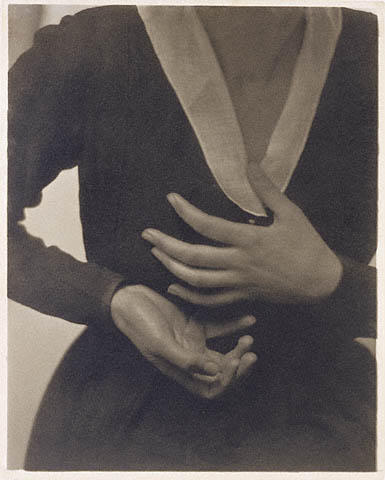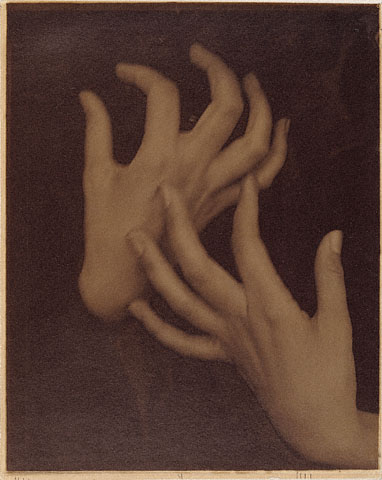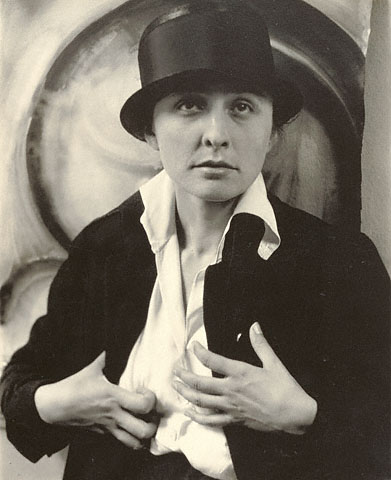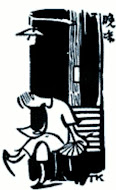做什么呢?戒掉晚上的无聊电视剧是个明智之举,越不看,越觉得那些都愚蠢之极。麻烦的是50多个频道里就没有一个真正意义的音乐频道。热闹的演艺新闻和各色MTV后,居然是没完没了的劣质广告。
看本书吧,拍拍掉灰尘。
叶芝的几行诗句就能让人安静,当然还是觉得译文不好,可惜原文尚不能读顺当。
然后就翻到了O'Keeffe,从头开始读,这次把字加进去看。
书,写得潦草,语句不通的地方挺多,好在我看起来也是一目十行,常常跳字漏字,没什么妨碍。
看图片,云上的世界很稀疏平常,但原来是个巨大的画幅,大得一些展厅都运不进,这样想来效果应该是完全不同。O'Keeffe老年时的作品,因为有邻居帮忙,所以记述里看出作幅画那么麻烦,完全是个体力活。
反复提到Stieglitz的照片,对Stieglitz给她拍的那许多照感到很好奇。多好,一流的摄影家和一流的人物,还有什么更好呢?
Stieglitz死后整理展出他的作品,因为照片尺寸各异,展览馆提议要修剪空白边缘便于码齐了好运输,说他们也是这么处理伦勃朗的,O'Keeffe立刻回击,‘那是因为他的妻子不在场。’
伦勃朗啊,他们这么处理他。这个名字是唯一在卢浮宫给我留下深刻印象的画家,在巨大的卢浮宫里努力竞走时。那幅画很神奇,画里的老者在书桌前忧虑沉思惶惑,身后的女子探头安抚他,柔和而充满慰籍,也许她是充满怜悯的灵感之神。灰暗的画面,我能清晰的感受到,是这个画面之外的一个伟大的心灵在沉思忧伤,它充满智慧,就隐藏在这画面和我之间的空气上方。时间空间在它面前软弱无力。
那幅画下面用金色的花体字标着,Rembrandt。长久当文盲让我觉得自己连读阿拉伯数字都不一定能理解正确,这个花体字让我很疑惑,猜想名字是不是会随语言不同而改变。猜想这个大概就是伦勃朗吧,反正也从没看过这个名字本来应该怎么写。
嗯,他们居然这么处理他。Stieglitz很走运,有O'Keeffe坚持,一点多余的空白边也不能裁。
Stieglitz, Alfred American (1864-1946)

"Stieglitz photographed me first at his gallery "291" in the spring of 1917. My hands had always been admired since I was a little girl. But I never thought much about it. He wanted head and hands and arms on a pillow in many different positions. I was asked to move my hands in many different ways also my head and I had to turn this way and that. Stieglitz had a very sharp eye for what he wanted to say with the camera. When I look over the photographs Stieglitz took of me, some of them more than sixty years ago, wonder who that person is. It is as if in my one life I have lived many lives. His idea of a portrait was not just one picture. His dream was to start with a child at birth and photograph that child in all of its activities as it grew to be a person and on throughout its adult life. As a portrait it would be a photographic diary." Georgia O'Keeffe, 1978

American, June 4, 1917
[Georgia O'Keeffe] is much more extraordinary than even I had believed. In fact I don't believe there has ever been anything like her. Mind and feeling very clear, spontaneous--& uncannily beautiful, absolutely living every pulse beat.
Early in Alfred Stieglitz's relationship with O'Keeffe he wrote this adulatory description of her to a friend. Stieglitz made this expressive study of O'Keeffee's nearly dancing hands and her torso, dressed in a crisp black dress with a sheer, voile shawl collar, reminiscent of the one she wore when they first met at his gallery. O'Keeffe, by then already an accomplished painter, expressed herself eloquently through her hands, and Stieglitz recognized their emotive potential.

American, 1918
"My hands had always been admired -but I never though much about it," recalled Georgia O'Keeffe when she looked at this photograph some sixty years after it was made. As part of the consuming passion for O'Keeffe that drove Alfred Stieglitz to leave his first wife and child, he conducted a great love affair with her hands through his camera. From the very beginning of their relationship, Stieglitz photographed O'Keeffe, eventually produced a cumulative portrait of more than 325 photographs.
Here photographed so that only her hands are visible, the dynamism of her gesture evokes the rhythms of music and dance as well as the abstract, biomorphic shapes of O'Keeffe's own drawings and paintings.

American, 1918
A striking figure in a smart hat, seductively open white shirt, and black jacket, Georgia O'Keeffe stands in front of one of her paintings and clutches at her breasts as if her hands contain a life force unto themselves. Her penetrating gaze above the camera transports her to a space the viewer cannot share.
From 1917 through the mid-1930s, Alfred Stieglitz photographed O'Keeffe, with whom he began a passionate relationship in 1918. He called the extended series of photographs he made of her Georgia O'Keeffe: A Portrait.

A Portrait: Georgia O'Keefe, 1918
One of the most significant photographers of the early twentieth century, Stieglitz said: "I was born in Hoboken. I am an American. Photography is my passion. The search for Truth my obsession." He also introduced modern European art to America through exhibitions in his New York galleries and supported the work of American modernist painters, including Georgia O'Keeffe, who became his wife. This image is part of Stieglitz's cumulative portrait in time, several hundred photographs made of O'Keeffe between 1917 and 1933. He believed that a single image was not always sufficient to capture the complexity of a human personality and that, as long as it expressed some aspect of the sitter, any part of the body could be a portrait.

O'Keeffe Hands and Thimble 1919






No comments:
Post a Comment